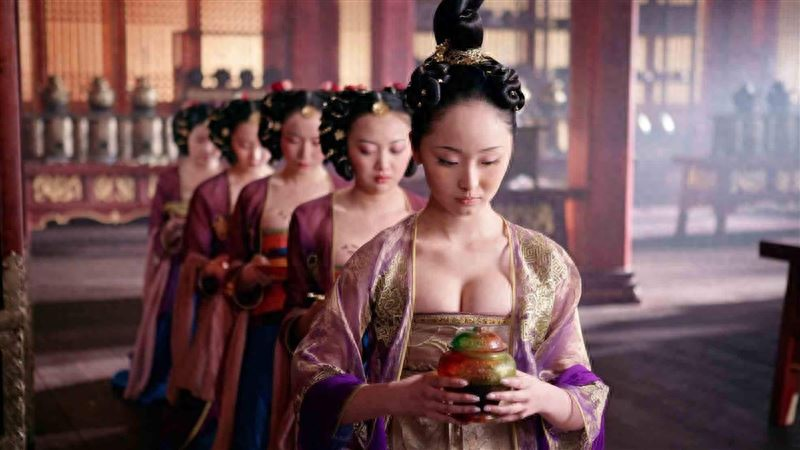When we think of ancient Chinese emperors, we imagine absolute power, lavish feasts, and an endless harem of concubines. But with great power comes great… logistical problems. Managing a palace full of concubines without triggering jealousy and drama? That’s no easy feat.
To maintain harmony in the harem, emperors came up with some truly bizarre ways to decide which lucky lady would accompany them for the night. Here are five of the most unusual methods ever used in Chinese history.

1. The Moon Cycle Method – A Cosmic Love Schedule (Zhou Dynasty)
The Western Zhou Dynasty (1046–771 BCE) was all about order and rituals, and that extended even to the emperor’s romantic schedule. The harem followed a lunar-based rotation system:
- From the 1st to the 15th day of the lunar month (as the moon waxed), lower-ranking concubines took turns accompanying the emperor.
- On the 15th—the night of the full moon—the queen received exclusive favor.
- From the 16th to the end of the month (as the moon waned), the lower-ranked concubines had their turn again.
This method ensured that everyone had a fair chance, while also aligning imperial romance with the cosmos. However, since there were far more concubines in the “low rank” category, the emperor sometimes had to entertain multiple ladies in one evening. Talk about celestial multitasking!
2. The Sheep-Drawn Carriage Lottery – A Woolly Affair (Jin Dynasty)
Fast forward to the Jin Dynasty, where Emperor Sima Yan (司马炎) found himself in a peculiar predicament: too many concubines, not enough nights. With thousands of beautiful women waiting for a chance to be noticed, how could he pick?
His solution? Leave it to chance… and sheep.
Every evening, he would hop into a small carriage drawn by sheep and let them wander through the palace. Wherever the sheep decided to stop, the concubine in that residence became the lucky winner of the emperor’s attention.
Of course, concubines quickly learned to game the system—some sprinkled salt or fresh grass near their doorways to lure the sheep. The emperor, however, didn’t seem to mind. This method even gave birth to the Chinese phrase “羊车望幸” (yáng chē wàng xìng), meaning “to eagerly await favor.”
3. Rolling the Dice or Following the Butterflies? (Tang Dynasty)
If Sima Yan’s sheep method was quirky, Tang Emperor Xuanzong (唐玄宗, r. 712–756 CE) took things to a whole new level of entertainment.
Initially, he used dice—concubines would roll, and the highest number determined who would be chosen for the night. Simple, fair, and infused with a bit of gambling excitement.
But the emperor, known for his poetic and romantic nature, later adopted an even more whimsical method: butterflies.
During spring and summer, he would release butterflies into the palace garden. Whichever concubine the butterflies landed on, that lady was selected. This not only made the process feel like a romantic fairy tale but also fit well with the Tang Dynasty’s love for art, nature, and spontaneity.
Imagine anxiously standing in a flower-filled courtyard, hoping that a butterfly picks you—romantic or nerve-wracking?
4. The Lantern Selection – A Silent Signal (Ming Dynasty)
By the Ming Dynasty, palace life had become even more rigid, and emperors needed a more discreet method to avoid jealousy-driven chaos. Enter the lantern selection system.
Each night, every concubine would hang two red lanterns outside her door. Instead of personally announcing his choice, the emperor would send a trusted eunuch to remove the lanterns of the chosen concubine.
The absence of lanterns was a silent but clear signal: she needed to prepare for the imperial visit. The other concubines, seeing their lanterns untouched, would simply turn in for the night, sparing them unnecessary heartbreak.
This approach kept palace drama to a minimum—no awkward public rejections, just a quiet game of “who’s still got their lights on?”
5. The Flip of a Plaque – Imperial Bureaucracy at Its Finest (Qing Dynasty)
The Qing Dynasty (1644–1912 CE) brought about the most famous method of all—the “flipping of the plaques” (翻牌子, fān páizi).
Each concubine had a name plaque (usually jade or wood), neatly arranged on a table. In the evening, the emperor would flip over the plaque of the woman he wished to summon.
Once chosen, the concubine would be carried (yes, literally carried in a blanket) to the emperor’s chambers by eunuchs—no chance for cold feet or last-minute cancellations.
This system, though methodical, was wrapped in layers of formality:
- Record-keeping was strict—every visit was documented.
- There were rules about pregnancies—concubines who conceived were given better treatment.
- Eunuchs ensured everything ran smoothly, making sure the emperor didn’t “accidentally” pick the same favorite too often.
It was romance, Qing-style—strict, structured, and very well-documented.
The Cultural Legacy – Love, Power, and Politics
Though these methods may seem bizarre or amusing today, they reflect the deep-rooted challenges of palace life:
- Balancing fairness in a highly competitive environment.
- Maintaining harmony in a harem filled with ambition.
- Reinforcing imperial authority—even love was dictated by law.
Modern parallels? Think about reality dating shows like The Bachelor—multiple contenders, one decision-maker, and plenty of drama. It seems that, throughout history, deciding “who gets the rose” (or in this case, the emperor’s favor) has always been a tricky business.
One thing’s for sure—no matter the era, love and power have always been an unpredictable game.

No comments yet.